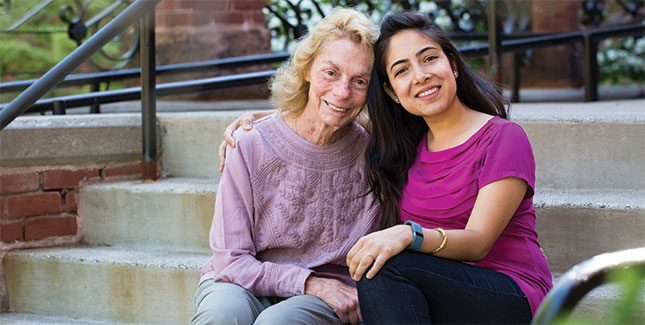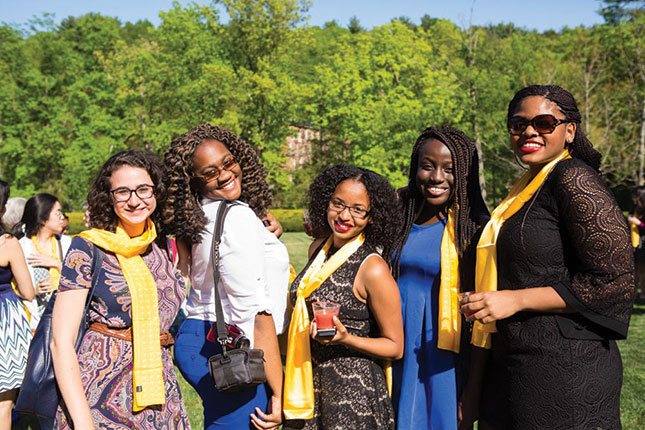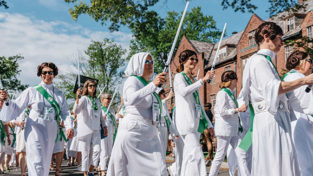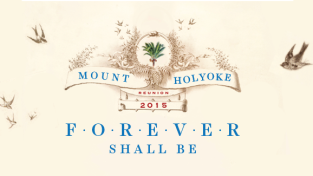Meaningful Moments
The Connections Program joins classes fifty years apart, helping alumnae and current students find common ground between generations—and changing lives in the process
In the summer of 2010, when Sandhya Banskota ’10 learned that she had been invited to a final round of interviews at a Boston management-consulting firm, she already had a ticket for a flight back to her native Kathmandu. In fact, her plane was scheduled to leave on the same day as the final interview. She had graduated from Mount Holyoke that spring and had decided to return to Nepal, where she planned to take an internship and look for work. She was confident she would be able to find a job back home on familiar turf. But she had stayed in the United States for the summer and now, quite unexpectedly, she was faced with a choice that could change the course of her life and career.
How she got to that point is a story in itself—one connected to her friendship with Dana Feldshuh Whyte ’60 and an evolving Mount Holyoke tradition that brings together new students and their fifty-year counterparts: alumnae who entered Mount Holyoke a half-century earlier.
Whyte, who lives in South Hadley, had been involved with her class’s outreach to the class of 2010, and she met the younger woman on campus soon after Banskota arrived as a first-year, finding her way at a new college and in a new country.
“We hit it off,” Whyte says. “You just do that with some people. She was very interested in getting to know me and my husband and getting to know the culture.”
Whyte had spent time trekking and rafting in Nepal and shared her stories with Banskota. As their friendship blossomed, Whyte sometimes attended Banskota’s classes and presentations or invited her for visits to the home she shares with her husband, Curtis Smith, a Mount Holyoke professor emeritus of biological sciences.
“One of our routines was to have breakfast at their house,” Banskota says. “After breakfast we would take the dog walking around the lake and up into the field, just talking all the way, and almost every month she’d take me out to a local Nepali restaurant—the Lhasa Café. Nepali dumplings are the best in the world, and she knew I loved them.”
Banskota even assisted Whyte in a nighttime, midwinter “elfing” mission, helping to deliver bags of treats and notes of encouragement to the class of 2010 just before exams. “If Sandhya and her posse hadn’t helped us,” Whyte says, “we’d still be there. As it was, we weren’t finished until about 3:00 a.m.”
After graduation, as Banskota planned her return to Nepal, she began to wonder if she might miss opportunities in the US. As she pondered, she turned to Whyte for advice.
“Dana is a friend,” Banskota says. “She has traveled the world, and she has a supremely broad mind. Any time I asked for suggestions, she would say, ‘Here’s what my experience has been like in a similar situation—just think about it.’ ”
Eventually Banskota decided to stay for the summer.
“I talked to Dana about it,” Banskota says, “and her attitude was very much ‘when you’re young, this is the time to explore things outside the box.’ I wouldn’t say she convinced me to stay, but she coaxed me not to just jump back into the safe path. And knowing she was close made my family more comfortable with it.”
The decision turned out to be a good one. That summer, while working for a friend of Whyte’s in an office near Boston, Banskota sent her resume to the management-consulting firm. The firm contacted her, and soon she was faced with a choice: return to Nepal, or cancel her ticket and attend the final interview.
Bonds between alumnae are a venerable tradition at Mount Holyoke. From career and networking opportunities to lifelong friendships, the shared experience in South Hadley generates connections of all kinds. But according to Jane Zachary, executive director of the Alumnae Association, the fifty-year connections are a recent and special development.
“This started as a grassroots initiative,” she says. “The interest and excitement about this came from the alumnae themselves.”
“Any time I asked for suggestions, she would say, ‘Here’s what my experience has been like in a similar situation—just think about it.’”
Sandhya Banskota ’10
A spark to kindle that enthusiasm was struck in 2005, when Professor Eleanor Townsley asked students in her Sociology 224 class to research alumnae from the class of 1955. Their work culminated in videotaped interviews with members of that class, and the alumnae, in turn, interviewed the students. The videos were eventually added to the College’s archives and, with help from the students, 1955 alumnae Joan Winkel Ripley and Nancy Leech Mohr, along with other members of the class, chronicled the project in a book called Uncommon Women Together—Generations Apart.
“When we started we had no idea that we were going to write a book,” says Ripley, who was vice-president of her class at the time. “It was fascinating to hear the interviews and to learn about the students’ experience in a place that we all love so much. It became apparent when the project was ending that we had to get it all down on paper.”
The fifty-year connections caught fire in 2007, when Whyte and her classmate Nancy Zone Bloom invited the class board of 2010 to a dinner at Willits-Hallowell. The event would be the first of a series of activities designed to nurture and build the connection between the two classes.
“We explained that they were very special to us, because in three years we would be together on this campus, celebrating two very important events in our lives: their graduation and our fiftieth reunion,” Whyte says.
After the Willits dinner, Whyte and Bloom became the coordinators of the 1960/2010 project, designing a series of activities to nurture and build the connection between the two classes. The relationships began as email matches were made between members of each class, and more than one hundred members of the class of 1960 adopted granddaughters—some more than one—providing advice, guidance, and, sometimes, just good fun. Almost four years later, members of the class of 1960 surprised the graduating seniors with a check for $2,010 to boost their treasury, a friendly admonition not to become too isolated by screens and headphones, and a Dixieland band to lead them from senior breakfast to graduation rehearsal.
The following year, inspired by the strength of this connection, the Alumnae Association invited fifty-year alumnae to usher in a new tradition during graduation week: the “scarving” ceremony. In Chapin Auditorium, alumnae from the class of 1961 lined up to present each new graduate with a silk scarf in her class color, decorated with her class animal in a ceremony that was a formal welcoming of graduating seniors into the Alumnae Association.
The fifty-year bond now has a formal name: the Connections Program. In May the Alumnae Association hosted the scarving, now the Welcome New Alumnae Ceremony. In a ceremony at Gettell Amphitheater on the Thursday afternoon before commencement, members of the class of 1965 became the fifth class to present graduating seniors with scarves, which have become a symbol of alumnae sisterhood.
“It has become a strong tradition very quickly and has become very meaningful,” Zachary says. “To have the scarf presented by a fifty-year class member is symbolic of connection—fifty years of continuity. We knew the two classes were already starting to build connections, and we wanted to facilitate the formal welcome as seniors become alumnae and continue those meaningful relationships.”

Meggie Lasher ’14 and Ellen Nutter ’64 live just miles apart in North Carolina. Photo by Ryan Bumgarner.
For some, those relationships are closely connected to place. Meggie Lasher ’14 was working as an assistant to the class of 1963 at their fiftieth reunion when she met Ellen Manfredonia Nutter ’64, who was observing the event to prepare for her own class’s upcoming reunion.
“Our class had initiated a ‘bridges’ program to make the fifty-year connection,” Nutter says. “One thing that was difficult was finding anyone you could see on any kind of sustained basis. So we had decided to look for people in our hometowns.”
It was a happy coincidence, then, when she encountered Lasher in the hospitality tent.
“I said I was from Asheville,” Lasher says, “and she just turned and stared at me. There are not many people from western North Carolina who can talk about Asheville and Mount Holyoke in the same breath. What started as a long work shift turned into this amazing serendipity.”
Lasher and her twin sister, Kate Lasher, who is also a member of the class of 2014, had grown up in Weaverville, ten miles north of Asheville.
“I’ve only been in Asheville for five years,” Nutter says. “They’ve been here their whole lives. When we talked, we realized that the twins had actually babysat for a family in my neighborhood.”
When the Lashers graduated, Nutter and her husband attended their graduation party in Weaverville.
“One of their uncles owns a working farm where they have events, and that’s where it was, with this beautiful mountain view,” Nutter says. “The house is from the early 1800s. It was wonderful to meet their family, and there was a country band playing—it is western North Carolina.”
“I think they like the depth of history at Mount Holyoke, and the sense that they are part of an institution that is still as strong and as worthwhile as it was in the past.”
Jamie Adkins Baxter ’65
Nutter herself grew up in Long Island. At Mount Holyoke she earned a double major in political science and English and went on to study city planning at Columbia University. She earned a master’s degree, then found a job as a researcher at the New York Times.
Lasher loves a story from that time that involves Nutter’s correcting a point of grammar, then standing up to
a supervisor who challenged her.
“Coming from Mount Holyoke, we know our voices matter,” Lasher says, “and we know how to assert that in a way that’s not angry or pretentious. It’s a way to help others learn to listen.”
For Lasher, part of the value in the fifty-year connections is in just these kinds of stories; another is in the sense of shared experience—not only with Nutter, but with her predecessors as well.
“Ellen talked to me about the Mount Holyoke College library and how the marble steps on certain staircases had been worn by the feet of women before her,” she says. “I worked in the library. After that conversation, going up the same steps, and noticing the marble worn down—it stopped me in my tracks. To think about the women who worked there, just like I was working there. We were doing the same thing. They marched up those steps with their bags full of books and got to work. This trivial thing became a marker of how special and how sacred my experience at Mount Holyoke has been.”
The response from the younger classes has surprised many of the alumnae who have worked to build connections through the generations. “We were delighted to see how interested they were,” says Jamie Adkins Baxter ’65, whose class was the first to contact their fifty-year class—the class of 2015—during their first year at Mount Holyoke. “But I think they like the depth of history at Mount Holyoke, and the sense that they are part of an institution that is still as strong and as worthwhile as it was in the past.”
A connection with the past is exactly what helped Elaine Kasparian Elliot ’62 and Stephanie Rohr ’12 find common ground.
When Elliot enrolled at Mount Holyoke in 1958, she thought she might be a chemistry major. Then she took a Latin course to fulfill a core requirement.
“I liked the problem-solving aspect of Latin,” she says. “There were all these endings to deal with, and I liked figuring out what case was appropriate, how the adjective agrees with the noun. I liked it at the basic level of language.”
It was at Mount Holyoke that she fell in love with classical literature, inspired by Professor Betty Nye Quinn ’41, who would later chair the College’s classics department, and by the sense of camaraderie among students and professors. After graduating with a degree in classics, Elliot pursued a master’s degree and then a doctorate in classics at Tufts, spending her first year as a master’s candidate in Cuma, Italy, a small town in the countryside outside of Naples, visiting archaeological sites and learning Italian, she says, “by turning Latin into Italian whenever I could—and succeeding maybe 75 percent of the time.”
She taught Greek, Greek drama, and Latin literature for a year at the University of Illinois before moving back to the Boston area, where her husband, James Elliot, was studying astronomy at Harvard. Elliot taught Latin for thirty-
five years in secondary schools in and around Boston, including the Dana Hall School in Wellesley and the Doherty Middle School in Andover, Massachusetts.
She met Rohr at a mini-reunion event in 2010.
“The class of 1962 invited us,” Rohr says. “It was our first contact as a class. Elaine joined our circle of conversation, and when I mentioned that I was in the classics department, her face just lit up.”
In the spring of 2011, shortly after the death of Elliot’s husband, Rohr mentioned that her girlfriend, Devora Kremer ’11, had enrolled in the AmeriCorps teaching program and was looking for an apartment near Boston.
“Devora stayed with me for a year,” Elliot says. “And when Stephanie graduated she asked if she could stay there, too. Their presence at a transitional time definitely provided a bright spot in my life.”
Of living at Elliot’s, Rohr says, “We were her ‘girls in the attic,’ and we got a chance to get to know Elaine and her friends.” Several of those friends were also Mount Holyoke graduates, and over dinner, bridge games, and trips to the theater, a sense of community formed.
“If [Rohr and Kremer] are representative of their generation, then the world is in good hands.”
Elaine Elliot ’62
“As with most of my connections to Mount Holyoke, the more time I spend with them, the better I feel about myself and the better I feel about Mount Holyoke,” Rohr says. “The College has influenced so many amazing people.”
When she graduated from Mount Holyoke and started a master’s program of her own at the School of Social Work at Simmons College in Boston, Rohr was grateful for Elliot’s presence in her life.
“I would check in with her about what was going on,” she says. “She would always give me support and reassurance but also her heartfelt opinions about graduating from college and becoming a real grownup. That strong emotional support has framed a lot of our time together.”
Rohr and Kremer have since moved to an apartment in Waltham, and the couple was married in 2012. Elliot attended the wedding and has visited their new home.
“They share their apartment with another woman in her early forties,” Elliot says. “Initially she thought she might be too old to be their roommate, but they said, ‘Our last roommate was seventy years old!’”
Their newest roommate is a lot younger.
“The big news is that I am now a Mount Holyoke great-grandmother!” Elliot says. “Stephanie and Devora had a baby in February, and I went to their house in Waltham for the naming ceremony. I really felt privileged—it was a small family group and me.”
As her relationship with Rohr and her family deepens, Elliot continues to find reasons in it for hope.
“It makes me feel young again,” she says, “remembering what it is to set out in life and make your choices and make your path and wondering and seeing what they’re going to do and experience. We’ve played games together, we’ve had lots of meals together, and I just think that if they exist, then others like them must, too. And if they are representative of their generation, then the world is in good hands.”
And Sandhya Banskota?
She canceled her ticket, and she got the job. Soon she was traveling the US as a consultant, learning the ropes in a role she came to love. She is now enrolled at Harvard Business School with a world of new possibilities to consider. Whatever comes next, however, her friendship with Whyte will be an important part of the journey.
“Not because she’ll give me a solution,” Banskota says, “but because she’ll listen, and it’s always comforting to talk to her. I’ve been doing it for eight or nine years now. I don’t see that changing any time soon.”
This article appeared in the summer 2015 issue of the Alumnae Quarterly.
—By Abe Loomis
Abe Loomis is a freelance writer based in western Massachusetts.
—Photography by Lynne Graves
July 12, 2015













Leave a Reply